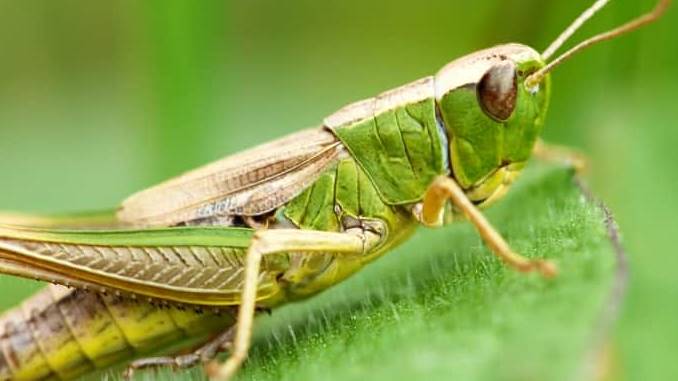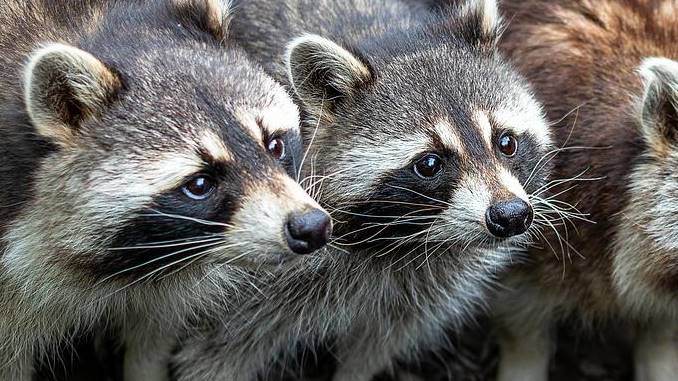Disclaimer: The information presented below is for general informational & educational purposes only. Always consult with animal professionals in case of specific concerns.
Grasshoppers are a widespread bug that may be found in many environments around the globe.
These herbivorous bugs may wreak havoc on the vegetable garden, fruits, and grasslands. They can destroy your crops once they assemble a swarm of locusts.
So, what eats grasshoppers? Natural predators such as birds, frogs, and lizards exist in abundance.
Let’s dive into this article to know more about some of the typical enemies of this species. Scroll down!
What Eats Grasshoppers?

Mammals that eat grasshoppers, such as red foxes, bats, raccoons, shrews, opossums, and rodents are known to be extremely powerful locust predators.
Grasshoppers are a type of insect that belongs to the Caelifera subfamily. They range in size from small to large, based on the genus.
Adults range in length from 0.39 to 2.75 inches. To merge into their surroundings, they have enormous, big compound eyes brilliantly colored with a blend of gray, brown, and green.
This species all begins their lives as eggs and evolves through many stages. Except for Antarctica, all continents have more than 11,000 varieties.
Most of them reside in dry open environments with plenty of grass, while a few thrive in forests or rainforests.
These animals eat plants. They consume plant leaves, seeds, stalks, flowers, and dead insects to get more protein.
These species may live for many years, but diseases, predators, drought, or winter kill most of them. Since they are solitary, they are easily preyed upon.
What eats grasshoppers? The list below will show you the most common hunters of this species. Keep reading to learn more!
#1. Dragonflies
A dragonfly’s broad wings make it incredibly strong for its size, allowing it to capture a grasshopper.
Their primary predatory strategy is the legs, which form a basket that works as a net, catching a minor bug in its path.
The dragonfly will then utilize these legs to keep the target firmly while simultaneously using the wings to maintain stability in the sky.
This feature enables them to consume their food while in flight, which is remarkable for such a small species.
Dragonflies can fly at about 30 kph, enabling them to keep up with faster and smaller insects such as mosquitoes.
Also, these animals can fly backward and stay in one spot, giving them an advantage against lesser creatures.

#2. Crested Flycatchers
The sizable crested flycatchers are one of the significant grasshopper predators, particularly in eastern North America.
Among other flying insects, Grasshoppers are a favorite food of these birds.
They will soar through the foliage in search of hiding insects attempting to defend themselves.
While crested flycatchers aren’t the most cunning predators, they are fully capable of collecting numerous insects in a single day to feed their nests.
#3. Bats
The bats, an outstanding hunter at night, can pose a danger to various small insects that they may find outside.
Most bats consume insects at times, while some bats only eat insects. That is why they are known as insectivores.
These animals with claws are excellent at eviscerating mosquito populations.
They will also hunt for grasshoppers, beetles, and other small insects around their surroundings.
They can catch insects off guard, especially in the dark while sleeping.

#4. Other Birds
Birds are one of the most popular predators of small insects, including grasshoppers.
There are numerous additional varieties of birds eating insects, including blackbirds, and bluebirds, in addition to the ones described above.
Blackbirds and bluebirds hunt grasshoppers in similar ways. Because they are small in size, they must be faster than these small insects to grab them.
Even chickens may grab insects when they discover them in grassland regions since these tiny bugs are often too fast for them!
Related: What Eats Birds In The Food Chain?
#5. Hedgehogs
Hedgehogs used to be classified solely as insectivores. However, this species is now considered omnivores, which make them perfect pets and easy to take care for.
Minor bugs, rodents, and various fruits, such as watermelon, are among the foods they consume.
The spiky and gorgeous animals aren’t famous for being ravenous predators, yet they’ll seize any opportunity to hunt bugs in nature.
They preferably eat grasshoppers and other species like snails, frogs, or toads.
#6. Hawks
Hawks are far more proficient hunters than turkeys and flycatchers, eating everything from grasshoppers to small mammals.
These animals will plunge from a great height, making insects easy targets.
While hawks like giant food like rodents, they will never turn down a grasshopper for a quick snack.
On the other hand, tiny insects are only the secondary food source for hawks.
#7. Raccoons
Raccoons are well-known for their resourcefulness. They can adjust to a variety of habitats.
You can find them practically anywhere on the planet. These creatures may live in the mountains, woods, or even cities.
These hairy animals must accept a variety of foods. If they reside in cities, they are content to eat scraps from human garbage.
However, they can catch tiny insects and rodents in the wild. And if things become rough, they’ll go for grasshoppers.
They prefer more enormous insects as they require more nutrients and protein to survive.
As a result, if these animals encounter these bugs in nature, they are unlikely to pass up the opportunity.

#8. Snakes
Green snakes, ring-necked snakes, or garter snakes, for example, are voracious bug eaters that live in grassy regions.
Snakes possess strong hunting instincts and can move quickly, so the smaller grasshopper has almost no chance of escape.
Insects consume and ruin the crops of many landowners in grassy areas, so these reptiles are welcome.
Some farmers may even utilize these wild snakes to wipe off grasshopper swarms to protect agricultural harvests.
This method is old but still practical and more helpful than using pesticides.
Read more: What Eats Snakes In The Food Chain?
#9. Red Foxes
Red foxes are among the most challenging predators in the forests. Do grasshoppers get eaten by foxes?
Yes! They have no qualms about catching a quick lunch like an insect and other minor bugs or rodents.
Foxes prefer to consume larger rodents like rats, mice, and other small mammals.
However, when those species become sparse due to several carnivores, red foxes may rely on smaller animals such as grasshoppers.
Related: What Eats Foxes In The Wild?

#10. Wild Turkeys
Wild turkeys are native to the grasslands of North America, where they feed on snakes and insects.
They are primarily foragers. Thus vegetables and fruit will be their primary source of nutrition.
They aren’t the best predators, so they will accept any sources of food they can discover.
They do, however, require meat-based diets to meet their protein requirements. They’ll be on the lookout for minor bugs and snakes to eat.
Turkeys are delighted when they come across a tiny, easy-to-capture insect. It’s for this reason that these animals hunt and eat grasshoppers.
Turkeys consume these small insects because they are a rich source of proteins, despite their stubbornness.
If you are curious about how wild turkeys hunt and eat these insects, you can watch this video:
#11. Tarantulas
Although tarantulas consume grasshoppers, it’s ideal for feeding insects raised in captivity to your pet. That’s because wild insects might transmit harmful diseases to your tarantula.
In addition, it’s best to feed your tarantula freshly killed bugs instead of active ones to avoid a battle that could hurt the tarantula.
A tarantula may swoop on an unaware insect and eat it for lunchtime outdoors!
Can Humans Eat Grasshoppers?
Have you wondered whether humans can eat grasshoppers? The short answer is yes. Humans have eaten these insects.
Insects might not always be popular in Western cuisines, but they are a staple of several traditional diets in other world regions.
People in several countries worldwide like Mexico, Uganda, and Thailand prefer eating these wild insects.
Surprisingly, many people eat them without concern because of the numerous dietary components included in grasshoppers.
Why do people eat these small insects? The main reason is that they’re a nutrient-dense superfood.
These insects are full of protein and include a range of minerals and nutrients:
- Vitamin A
- Vitamin B
- Iron
- Calcium
- Manganese
- Magnesium
- Potassium
In addition, edible insects such as grasshoppers have a lower cholesterol content than animal-based diets. So, they may be a healthier alternative to meat.
Most of these insects are safe and delectable to enjoy. However, wild ones may carry parasites or come into touch with toxic chemicals.
Find a reliable retailer specializing in food products if you want to try grasshoppers.
How Do Grasshoppers Protect Themselves?
Grasshoppers must find techniques to defend themselves from potential predators.
Grasshoppers aren’t famous for biting. So, how do these insects protect themselves?
- Jump away: Grasshoppers can typically jump away from enemies thanks to their vast, muscular legs. They can utilize their strong legs to propel themselves off even if restrained.
- Fly away: This species has wings to fly away. Although they’re not great flyers, they can get far distances to stay safe.
- Spit: When provoked, these animals spit out a brown poison called tobacco juice. This foul-tasting liquid mainly comes from digestive enzymes and food.
- Create poison: Some of these creatures are aposematic, which means they’re toxic and have brilliant colors to scare off predators.
In A Nutshell
This article has eventually solved your question: What eats grasshoppers?
This insect has several predators like hawks, foxes, bats, snakes, and raccoons.
Besides wild animals, humans are also a significant threat to these insects. They catch them for food or to prevent this species from ruining their crops.

Hi, my name is John, and I’m an animal lover. I’ve been fascinated with the animal kingdom since I was 5 years old, and my passion keeps growing bigger as I age. And this blog is where I share my researches and passion with animal lovers all around the world.
